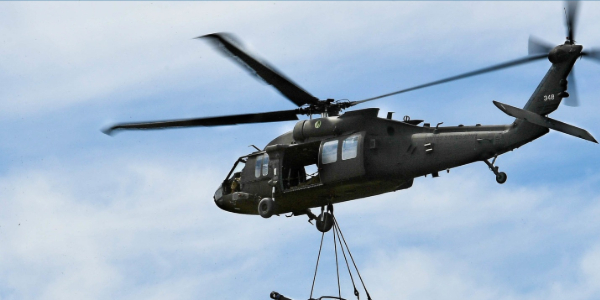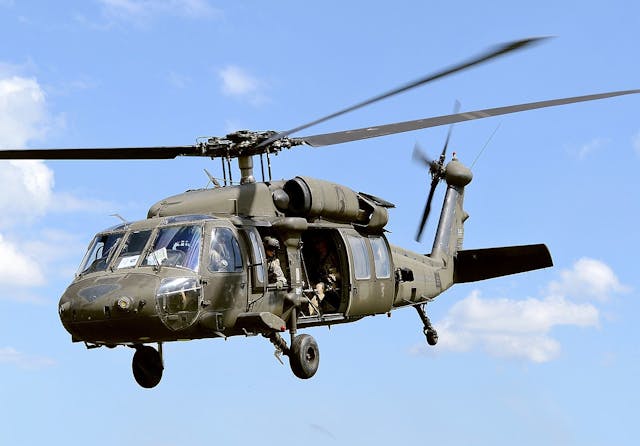How the Blackhawk Helicopter Offers Unrivaled Performance in Challenging Environments
How the Blackhawk Helicopter Offers Unrivaled Performance in Challenging Environments
Blog Article
Blackhawk Helicopters: Transforming Military and Civil Air travel
The introduction of Blackhawk helicopters in the late 1970s noted a significant evolution in both army and civil aeronautics. Their multi-role abilities have actually not just changed military operations however have actually additionally discovered considerable applications in civilian industries such as emergency services and catastrophe action. The assimilation of innovative technologies has additionally boosted their operational performance and reliability. As we analyze their extensive influence, it is vital to think about the future trajectory of Blackhawk air travel and the difficulties that might lie ahead in a quickly altering landscape. What ramifications could this hold for the next generation of airborne operations?
Background of Blackhawk Helicopters
Historically, the advancement of Blackhawk helicopters began in the 1960s, driven by the USA Military's need for a flexible energy airplane to replace the aging fleet of helicopters in solution at that time. The Military looked for a system that can execute a range of objectives, including army transport, clinical emptying, and logistical support, with boosted speed, payload, and variety capacity. In 1972, Sikorsky Airplane Company was granted the contract for the brand-new style, which would become called the UH-60 Blackhawk.
The Blackhawk's design was identified by advanced innovations, consisting of a twin-engine arrangement, a four-blade primary rotor system, and a durable airframe developed for toughness in combat circumstances. The first flight of the prototype happened in 1974, and by 1979, the Blackhawk went into service, quickly ending up being a foundation of the Military's aeronautics capacities. Its functional adaptability and dependability were noticeable in various military operations throughout the 1980s and past. Throughout the years, the Blackhawk has actually undergone many upgrades, ensuring its significance in modern warfare while also leading the method for its adaptation in civil aviation duties, further strengthening its status as a legendary aircraft.
Armed Force Applications and Influence
The versatility of the UH-60 Blackhawk has made it an essential property in numerous armed forces applications since its intro. Designed for multi-role capacities, the Blackhawk supports army transportation, medevac procedures, reconnaissance missions, and logistical assistance. Its ability to operate in varied settings, from city setups to tough terrains, enhances its efficiency in combat and humanitarian goals alike.
Blackhawks have actually played essential roles in numerous army operations, consisting of the Gulf War and operations in Somalia and Iraq. They master fast troop deployment and emptying, dramatically improving operational effectiveness and feedback times. The helicopter's sophisticated avionics and trip systems enable precision goals under damaging weather and at evening, consequently making the most of objective success prices.
Moreover, the Blackhawk's robust building and construction and effective performance enable it to hold up against hostile settings, making it a favored choice for unique operations pressures. Its influence expands past direct battle roles, as it has additionally contributed in calamity relief and recovery efforts, showcasing its adaptability and dependability. The continued development of the Blackhawk's capacities ensures its relevance in modern-day military approach, solidifying its tradition as a cornerstone of military aviation.
Technological Technologies
Numerous technological advancements have considerably boosted the capabilities of the UH-60 Blackhawk, guaranteeing it stays at the center of armed forces air travel. One of the most significant developments is the integration of innovative avionics systems, which offer pilots with real-time data, maximizing situational recognition and decision-making. The intro of digital cabin display screens replaces traditional analog tools, minimizing and simplifying procedures pilot work.
In addition, the incorporation of composite materials has enhanced the helicopter's architectural honesty while decreasing weight, thereby boosting gas effectiveness and haul ability. The Blackhawk's rotor system has actually likewise developed, featuring quieter and extra efficient blades that decrease noise signatures, critical for covert operations.
In addition, the application of fly-by-wire technology boosts flight control precision and security, permitting far better efficiency in various environments. Improved interaction systems make it possible for protected and trusted information exchange, assisting in collaborated missions.
The adaptability of the Blackhawk has actually also been boosted via modular layout, permitting rapid reconfiguration to satisfy diverse mission needs. These developments collectively ensure that the UH-60 Blackhawk remains an important asset in the toolbox of modern-day army forces, efficient in reacting successfully to an array of functional difficulties.
Civilian Profits and uses


Additionally, Blackhawks are utilized in firefighting procedures, especially in difficult surfaces. Equipped with water buckets or airborne firefighting modern technologies, they boost the abilities of landing crew, making it possible for much more reliable feedbacks to wildfires. The helicopters have discovered functions in regulation enforcement and search-and-rescue objectives, strengthening public safety and security initiatives in urban and wild setups.
In the world of infrastructure support, Blackhawk helicopters are made use of for transport of workers and devices to hard-to-reach places, such as oil well and remote construction sites. The flexibility of these aircraft, incorporated with their robust design, supplies both performance and dependability, visit this site making them indispensable properties across different sectors in the private landscape. Hence, the Blackhawk helicopter remains to make considerable contributions beyond its army heritage.
Future of Blackhawk Aviation
Emerging technologies and shifting operational demands are poised to form the future of Blackhawk aeronautics significantly. As noncombatant and armed forces sectors significantly focus on flexibility and performance, innovations such as sophisticated avionics, synthetic knowledge, and boosted materials will redefine the capabilities of Blackhawk helicopters - Blackhawk Helicopter. These advancements will not just boost flight efficiency yet likewise enhance objective preparation and execution through real-time information analysis and decision-making assistance

Furthermore, sustainability will become a focal point in future Blackhawk layouts. Establishing crossbreed or electric propulsion systems can minimize the environmental effect of army and noncombatant operations, straightening with worldwide efforts to battle environment adjustment.
Verdict
Finally, Blackhawk helicopters have significantly transformed both civil and military aeronautics because their beginning. Their multi-role abilities have proven important in various operational contexts, from fight to emergency situation services. Technological improvements have actually further improved their efficiency and adaptability, ensuring ongoing relevance in modern-day aviation. As future growths in aviation modern technology emerge, Web Site the Blackhawk's function is likely to broaden, solidifying its standing as an important asset across varied fields in the coming years.
The introduction of Blackhawk helicopters in the late 1970s noted a considerable advancement in both civil and army aeronautics. The continued development of the Blackhawk's capacities guarantees its relevance in contemporary military technique, solidifying its legacy as a keystone of military aeronautics.
Countless technological advancements have actually significantly improved the capacities of the UH-60 Blackhawk, ensuring it remains at the forefront of army air travel. As noncombatant and military sectors progressively focus on adaptability and effectiveness, innovations such as sophisticated avionics, artificial intelligence, and enhanced products will redefine the capacities of Blackhawk helicopters.In final thought, Blackhawk helicopters have actually considerably transformed both military and civil aviation considering that their read the article creation.
Report this page